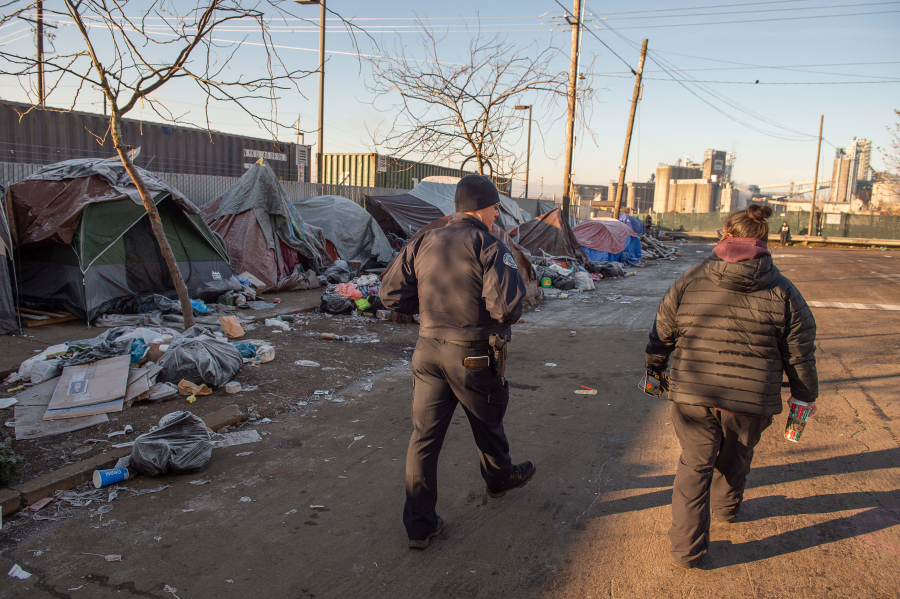A day after a report showed 1,300 people in Clark County were experiencing homelessness, local agencies refined their response for next year.
Data from the annual point-in-time count — a one-day event that identifies people who live outside or in shelters — took place on Jan. 26. It showed that 103 more local people are experiencing homelessness since last year.
Lasting impacts from the COVID-19 pandemic and high rental rates are driving homelessness up. But the data also pointed to the success of local housing solutions, like Safe Stay communities.
“Homelessness does not exist in a vacuum. Rates of homelessness (and rates of people ending their homelessness) are influenced by the availability of affordable housing, the economy and wages, access to physical and behavioral health care, and the fact that many people are still trying to restore their stability post-pandemic. We must listen to people with previous and current lived experience of homelessness and focus on the needs of the most vulnerable in our community — people historically marginalized and people on fixed incomes due to age or disability,” said Charlene Welch, communications director for the Council for the Homeless in an email.
What is causing these numbers?
The 1,300 people identified during the late January count included people living outside, in shelters or in some form of transitional housing. The data showed more unsheltered homelessness this year, 672 people, an 8 percent increase from 2022.
“What jumped out to me was that we had an increase in unsheltered numbers between last year and this year. It doesn’t look like a massive increase. But to me, it’s notable because we added like 100 shelter beds communitywide and we still had a growth in unsheltered homelessness,” said Jamie Spinelli, homeless response coordinator for the City of Vancouver.
Chronically unsheltered homeless individuals — someone experiencing housing instability for a year or more — increased by 78 percent from 2022.
“That’s a pretty significant jump,” Spinelli said. “It is probably due to a combination of things – chronically homeless people remaining outside, people ‘aging’ into chronic homelessness — meaning maybe they weren’t chronic last year but now since they’ve stayed outside they are considered chronic. I suppose there are all kinds of reasons we are seeing these numbers.”
People of color, young adults, seniors and families with children experiencing homelessness also increased. Unsheltered veterans’ homelessness rose by 33 percent, from 24 in 2022 and 32 in 2023.
Council for the Homeless officials attributed the influx to various things, specifically the high cost of living. A one-bedroom apartment in Clark County costs, on average, $1,500, and a recent study found that Washington has the sixth-lowest vacancy rate for rental units nationwide.
The agency also noted that people are still facing the lasting impacts of the COVID-19 pandemic. Since 2020, homelessness has increased by more than 300 people. Many residents still manage ongoing health needs and loss of income.
But not all the numbers highlighted in the annual report were bad. More than 400 people were living in an emergency shelter — an increase of 10 percent from 2022. Another 200 people lived in transitional housing, up 9 percent from the prior year.
The increase in emergency shelter residents was partly due to Bertha’s Place opening to total capacity and a second Safe Stay, Hope Village, added last spring. Within the first year of Hope Village, 56 were housed.
Spinelli also said that Safe Stay has played a part in transitioning people off the streets and toward the housing pathway.
“They’re small in size but they do serve a great number of people, in my opinion,” Spinelli said.
What’s next?
The next Point in Time Count will occur on Jan. 25, 2024, and housing officials say that engagement and collaboration will be part of the solution to lower numbers next year.
Spinelli said that the city will continuing building the remaining Safe Stay communities, up to five total.
“My goal once we get the fourth and fifth Safe Stay open is to really start focusing on continuing supportive and stabilizing services for everybody on those sites,” she said. “The providers who run these sites are already doing a great job but I would really like to focus my efforts to ensure that all the tools these folks need to successfully transition out of homelessness are there.”
Studies show that having access to mental health, substance use treatment, and other housing services increases the chances of someone staying housed permanently.
“There are multiple ‘levers’ to adjust which together can stem the tide of homelessness. Some of the levers are legislative action, building affordable housing, and investing in housing and homelessness assistance programs that data shows are effective — and could be even more effective if resources are invested to take them to scale to meet the need,” said Welch. “Each of these and all other solutions require collaboration across multiple sectors and entities.”
Solutions and snapshots
The number and demographics of those experiencing homelessness in Clark County is much more complicated. Welch reminded community members that the point-in-time count is only a portion of a much more comprehensive issue.
“It is critical that people understand the PIT is a snapshot of one day,” Welch said. “It does not illustrate the full picture of our Homeless Crisis Response System.”
The Homeless Crisis Response System is a comprehensive data collection showing demographics and homelessness’s inflows and outflows. On June 27, Council for the Homeless will host a webinar outlining homelessness demographics and service activity for 2022. Register at: https://www.councilforthehomeless.org/community-education/.




